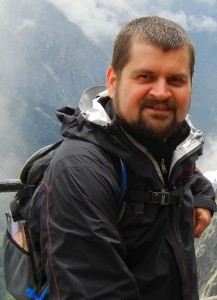Fluid Inclusion Analysis
Fluid inclusions are droplets of fluid trapped as imperfections within a growing crystal/mineral, or during healing and sealing processes in fractures in minerals. Acting as natural time capsules fluid inclusions are one of the best tools in geochemistry for determining the pressure, temperature, and composition of fluids associated with the formation of the host mineral and rock, and their subsequent history.
The SDI initiative maintains a modern fluid-inclusion analysis facility and an experimental hydrothermal laboratory capable of creating artificial fluid inclusions.
Fluid Inclusion Research Program
Fluid inclusions are a key to unlocking the history of fracture growth. Our recent fluid inclusion studies on crack-seal fracture cements that formed during fracture opening have provided age constraints on fracture formation based on correlations of temperature trends obtained using fluid inclusion microthermometry of crack-seal fracture cement with independently derived temperature history models. Raman data also allows pressure history to be inferred.
Andras Fall leads SDI’s fluid inclusion research effort. He conducts fluid inclusion measurements and trains students and staff in use of the laboratory equipment and interpretation of the results. Fall also conducts research using Raman spectroscopy, coordinates our liaison with Virginia Tech on Raman work, and conducts scanning electron microscope-based CL imaging in support of fluid-inclusion studies.
Fall also designed and directs the experimental hydrothermal facility.
Fall’s research combines low-temperature geochemistry (fluid inclusions) and fracture analysis addressing fracture formation and cementation mechanisms, fracture timing, and pore pressure evolution in sedimentary basins, and fractured and unconventional reservoirs.
Among the developments stemming from the use of fluid-inclusions in the SDI program is the first reconstruction of the entire opening history of an individual fracture.
Current research includes reconstructing the evolution of entire fracture arrays.
The fluid-inclusion research program has been integral in testing models of fracture cement precipitation.
Currently underway are observational and experimental studies of fracture cement precipitation and fluid inclusion trapping.
The following papers reflect some of Fall’s current research:
- Natural hydraulic fracturing of tight-gas sandstone reservoirs, Piceance Basin, Colorado. Fall, A., Eichhubl, P., Bodnar, R.J., Davis, S.J., Laubach, S.E., 2015. GSA Bulletin, v. 127, no. 1-2, p. 61-75, doi:10.1130/B31021.1.
- Whole Earth geohydrologic cycle: From the clouds to the core: The distribution of water in the dynamic Earth system, Bodnar R.J., Azbej T., Becker S.P., Cannatelli C., Fall A., Severs M.J., 2013. In Bickford, M.E., ed., The Web of Geological Sciences: Advances, Impacts, and Interactions: Geological Society of America Special Paper 500, p. 431-461, doi:10.1130/2013.2500(13).
- Testing the basin-centered gas accumulation model using fluid inclusion observations: southern Piceance Basin, Colorado. Fall A., Eichhubl P., Cumella S. P., Bodnar R. J., Laubach S. E., Becker S. P., 2012. AAPG Bulletin, v. 96, no. 12, p. 2297-2318. doi:10.1306/05171211149
- Combined microthermometric and Raman spectroscopic technique to determine the salinity of H2O-CO2-NaCl fluid inclusions based on clathrate melting. Fall A., Tattitch B., Bodnar R. J., 2011. Geochimica et Cosmochimica Acta, v. 75, p. 951-964. doi:10.1016/j.gca.2010.11.021
About the Fluid Inclusion Laboratory
Our Fluid Inclusion Laboratory includes a FLUID, Inc.-adapted USGS-type gas flow heating/cooling stage and a Linkam THMSG 600°C programmable heating/cooling stage. The stages are used on a Olympus BX 51 optical microscope, fitted for use with transmitted, reflected, and UV light, and equipped with 4×, 10×, 40×, 50×, and 100× objectives and 15× oculars. The microscope is also equipped with a 5.0 Megapixel OLYMPUS Q-Color5TM digital camera coupled with QCapture PRO digital imaging software. The lab is fully equipped with sample preparatory facilities for cutting and preparing doubly polished thin and thick sections.
András Fall is profiled on the Bureau of Economic Geology web site. Fall conducts research on fractures using fluid inclusion, Raman spectroscopy, and CL methods, and studies fluids in diagenetic and hydrothermal systems. Fall’s hydrothermal laboratory is exploring processes that help preserve and destroy fracture porosity. See the article
Hydrothermal Laboratory at the Bureau of Economic Geology
Information about the SEM CL Facility



